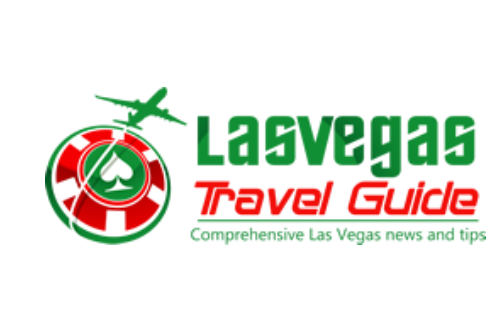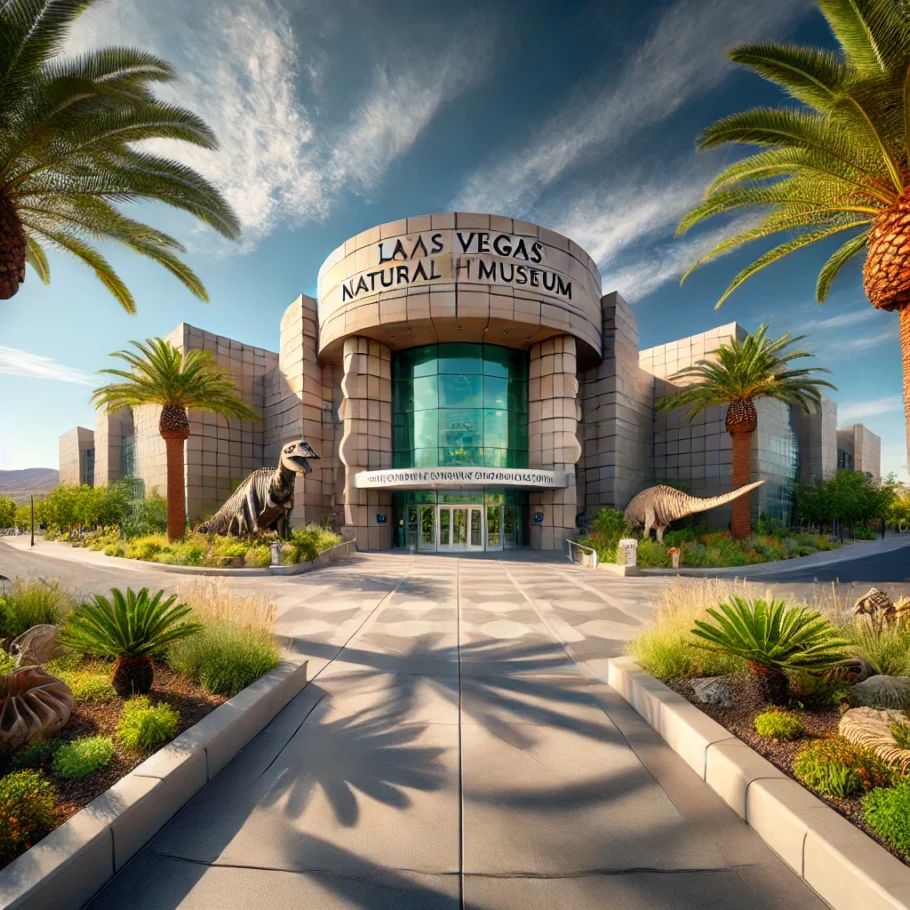Las Vegas might be known as the city of bright lights and endless entertainment, but beyond the neon glow lies a treasure trove of educational and cultural experiences. Nestled near downtown Las Vegas, the Las Vegas Natural History Museum (LVNHM) stands as a must-visit destination for locals and tourists alike. Having lived in this vibrant city for two decades, I can confidently say that this museum is one of the best ways to take a break from the bustling Strip and dive into an enriching world of natural wonders.
Stop right here – Vegas insider tip: Most visitors to this site will overpay by $727+ per trip to Las Vegas. Why? Because they don't have the secrets and tips to keep expenses low in Vegas while having a good time. Want the complete playbook for traveling like a Vegas local? Click here to save money on Vegas trips
In this article, I’ll share everything you need to know about visiting the Las Vegas Natural History Museum, highlighting its main attractions and offering insider tips to make the most of your trip. Let’s explore its many facets.
Exhibits That Transport You Through Time and Space
The Las Vegas Natural History Museum is a gateway to the past, present, and future of our planet. The exhibits are carefully curated to transport visitors across continents and eras, making every corner of the museum a new adventure.
Dinosaur Gallery
Step into prehistoric times as the Dinosaur Gallery showcases life-size models of these ancient giants.
Highlights:
- Marvel at the Tyrannosaurus rex exhibit, complete with animatronic features that bring this predator to life.
- Explore the skeletal replicas of herbivores like the Triceratops.
- Discover fossils and learn about the processes paleontologists use to uncover these ancient treasures.
- Interactive screens let kids (and adults) simulate a dig and piece together dinosaur bones.
- Don’t miss the comparative exhibit showing how birds evolved from dinosaurs.
Tips:
- Arrive early to beat the crowds and have uninterrupted views of the animatronic displays.
- Bring your kids to participate in the mini fossil-digging activities offered at specific times.
- Wear comfortable shoes; you’ll be standing for most of your visit.
- Take photos of your favorite displays, but remember to turn off the flash to preserve exhibit quality.
- Check the schedule for docent-led tours that provide fascinating behind-the-scenes insights.
Marine Life Gallery
Dive into the ocean’s mysteries with displays that showcase marine ecosystems and creatures.

Highlights:
Stop right here – Vegas insider tip: Most visitors to this site will overpay by $727+ per trip to Las Vegas. Why? Because they don't have the secrets and tips to keep expenses low in Vegas while having a good time. Want the complete playbook for traveling like a Vegas local? Click here to save money on Vegas trips
- View lifelike models of sharks, whales, and other sea creatures.
- Touch and feel shells and coral samples at the interactive marine touch station.
- Learn about the diverse ecosystems of coral reefs and the challenges they face due to climate change.
- Stand in awe under the life-size humpback whale model suspended from the ceiling.
- Explore the aquarium section featuring live marine species.
Tips:
- Ask the staff about feeding times for the live exhibits; they often offer fascinating insights.
- Bring a notepad if you’re interested in conservation efforts; the displays are full of useful info.
- Make time for the short educational videos on marine biology playing throughout the gallery.
- Engage with the touch tank to get hands-on experience with marine textures.
- Stay curious—ask staff about ways you can support ocean conservation locally.
Journey Through Local History and Wildlife
Beyond its global displays, the LVNHM also highlights Nevada’s natural and cultural history, showcasing the beauty and complexity of the Mojave Desert.
Treasures of Egypt Exhibit
A surprising gem in the museum is its tribute to ancient Egypt.
Highlights:
- Gaze at a replica of King Tutankhamun’s tomb and artifacts.
- Learn about ancient Egyptian burial practices and hieroglyphics.
- Examine detailed replicas of the Rosetta Stone and other iconic discoveries.
- Explore hands-on activities where kids can create their own hieroglyphic scrolls.
- Delve into the significance of ancient Egyptian gods and their symbology.
Tips:
- Watch the informational video loop for a condensed history of King Tut’s life and reign.
- Spend time analyzing the intricate details on the tomb replica—it’s surprisingly accurate.
- Bring kids to the craft area, where they can make take-home souvenirs.
- Avoid peak hours for quieter exploration, especially on weekends.
- Use this exhibit as a chance to connect global history with local educational opportunities.
Wild Nevada Gallery
A tribute to the flora and fauna of the Mojave Desert and surrounding regions.
Highlights:
- Learn about desert creatures like the Gila monster, desert tortoise, and rattlesnake.
- Observe taxidermied examples of native species alongside interactive panels.
- Discover the adaptations that help wildlife survive harsh desert conditions.
- Check out the live animal displays featuring reptiles and arachnids.
- Gain insight into the geological formation of iconic landmarks like Red Rock Canyon.
Tips:
- Ask the staff about live animal interactions; they sometimes bring out creatures for demonstrations.
- Make note of the desert survival tips offered in the exhibits—they can be surprisingly practical.
- Visit during off-peak hours for an immersive experience in the soundscaped desert environment.
- Encourage kids to complete the activity sheets provided near the entrance of the gallery.
- Use this opportunity to plan a future trip to nearby natural landmarks.
International Wildlife Gallery
Take a trip around the world without leaving Las Vegas.
Highlights:
- View realistic dioramas featuring animals from Africa, Asia, and the Americas.
- Learn about the conservation efforts to protect endangered species.
- Examine displays of predator-prey relationships and animal behaviors.
- Admire the detailed taxidermy work that brings these exhibits to life.
- Explore the impact of human activity on global wildlife populations.
Tips:
- Pay attention to the educational plaques—they’re packed with fascinating facts.
- Use this gallery as a teaching moment for kids about biodiversity and conservation.
- Look for the scavenger hunt cards near the entrance for an interactive experience.
- Check for rotating exhibits that might showcase rare or unique specimens.
- Bring binoculars if you want a closer look at some of the higher displays.
Engels Gallery of Prehistoric Mammals
Discover the giants that roamed the Earth after the age of dinosaurs.
Highlights:
- Marvel at the towering skeletons of mammoths and saber-toothed cats.
- Learn about Ice Age climates and how they shaped the animals of that era.
- Study the fossils of megafauna and their adaptations for survival.
- See replicas of ancient tools used by early humans to hunt these creatures.
- Interactive displays show the migration patterns of prehistoric animals.
Tips:
- Plan extra time for this gallery—it’s a favorite among visitors.
- Ask staff about recent fossil discoveries, as the museum frequently updates exhibits.
- Encourage kids to engage with the hands-on displays to make learning fun.
- Use the QR codes found on displays for additional digital content.
- Bring a notebook for any budding paleontologists in your group to jot down interesting facts.
African Savannah Exhibit
This exhibit immerses visitors in the diverse ecosystems of the African Savannah, complete with lifelike dioramas.
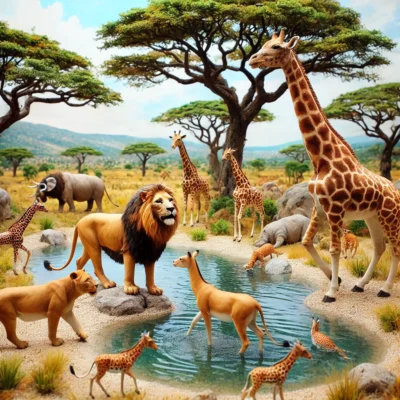
Highlights:
- View majestic lions, elephants, giraffes, and zebras in detailed recreations of their natural habitats.
- Learn about predator-prey dynamics and the role of apex predators in the ecosystem.
- Discover the seasonal migrations of wildebeests and other species through interactive maps.
- Explore the importance of water sources like rivers and watering holes in sustaining life.
- Examine traditional African artifacts and their connection to local wildlife.
Tips:
- Take your time exploring the dioramas; the level of detail is impressive.
- Read the conservation stories about efforts to protect endangered African species.
- Use this exhibit to teach kids about biodiversity and the balance of ecosystems.
- Check for docent-led tours to get an in-depth perspective on the animals and environment.
- Look for QR codes on displays to access additional educational content online.
Engelstad Family Prehistoric Life Gallery
This gallery dives deeper into the age of the dinosaurs and their evolutionary journey.
Highlights:
- Fossils of marine reptiles that swam during the time of the dinosaurs.
- Detailed timelines tracing the evolution of life on Earth.
- Insights into the extinction event that wiped out most dinosaur species.
- Displays about early mammals that began to rise after the dinosaurs’ extinction.
- Interactive displays that allow visitors to simulate fossil excavations.
Tips:
- Don’t miss the “What Came Before” section, which explores life before dinosaurs.
- Engage kids with the fossil dig activities in the gallery.
- Use the timeline displays to connect the dots between different prehistoric eras.
- Check the museum calendar for rotating exhibits related to paleontology.
- Ask staff about Nevada’s own prehistoric discoveries, like Ice Age fossils found in the region.
Educational and Family-Friendly Activities
The LVNHM is designed to entertain and educate visitors of all ages. If you’re visiting with family, you’re in for a treat.
Young Scientists Center
A space designed specifically for children to explore science in an engaging and interactive way.
Highlights:
- Hands-on experiments that teach principles of physics, chemistry, and biology.
- Activity stations for building structures, solving puzzles, and testing theories.
- A mini-lab where kids can examine specimens under microscopes.
- Learn about energy, water cycles, and renewable resources through interactive displays.
- STEM-focused activities that encourage curiosity and problem-solving.
Tips:
- Plan to spend at least 30 minutes here—it’s hard to pull kids away once they start.
- Encourage children to ask questions and explore at their own pace.
- Look for museum staff facilitating special activities or demonstrations.
- Take home STEM activity guides available near the entrance of the center.
- Use this as a break between other galleries to keep young visitors engaged.
Kids’ Discovery Room
A hands-on area designed to engage young minds.
Highlights:
- Engage with interactive learning stations about geology, biology, and paleontology.
- Explore sensory experiences, from touching fossil replicas to digging in sand pits.
- Join scheduled storytime sessions focused on natural history themes.
- Participate in creative crafts, like making dino masks or painting rocks.
- Discover the interactive water table designed to teach principles of erosion and water movement.
Tips:
- Visit earlier in the day when energy levels are high and the area is less crowded.
- Bring hand sanitizer; kids love to touch everything.
- Keep an eye on the time—some activities run on a schedule, so plan accordingly.
- Encourage kids to ask questions to get the most out of the experience.
- Capture their creations—many craft stations allow kids to take home their work.
Geology Gallery
A fascinating exploration of Earth’s physical structure, from volcanic activity to precious minerals.
Highlights:
- Discover a dazzling collection of gemstones, crystals, and minerals.
- Learn about plate tectonics and how mountains, valleys, and earthquakes are formed.
- Examine volcanic rock samples and learn about eruptions through interactive displays.
- See a collection of meteorites and understand their impact on Earth’s history.
- Interactive exhibits let visitors simulate volcanic eruptions and earthquakes.
Tips:
- Spend extra time at the gem collection—it’s one of the museum’s most beautiful displays.
- Encourage kids to try the interactive “Build a Volcano” simulator.
- Take photos of your favorite mineral samples for inspiration (non-flash photography allowed).
- Look for the timeline exhibit that explains how Nevada’s geology developed over millions of years.
- Use the educational videos to reinforce concepts like plate tectonics and mineral formation.
Living History Exhibit
This exhibit bridges the gap between nature and culture, offering an anthropological perspective.
Highlights:
- Displays of indigenous tools, clothing, and cultural artifacts from various regions.
- Insights into how humans have interacted with and adapted to their environments over time.
- Learn about early farming, hunting, and settlement practices.
- Examine the progression of human tools from the Stone Age to the Iron Age.
- See replicas of ancient shelters and learn about early forms of communication.
Tips:
- Pay attention to the interactive timelines that connect cultural advancements to natural events.
- Use this section to discuss with kids how humans have relied on nature for survival.
- Look for hands-on areas where visitors can try ancient techniques like grinding grain.
- Check for temporary exhibits that focus on specific cultures or regions.
- Engage with museum staff to learn more about the importance of preserving cultural artifacts.
Insider Information for Your Visit
Planning a trip to the LVNHM? Here’s everything you need to know to make the most of your visit.
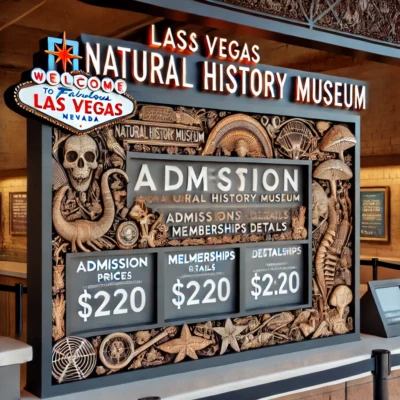
Admission and Hours
- Open daily from 9 AM to 4 PM, including holidays.
- Affordable ticket prices with discounts for children, seniors, and Nevada residents.
- Memberships are available for frequent visitors and include perks like free entry and discounts on workshops.
Getting There
- Located at 900 Las Vegas Blvd N., it’s just a few minutes’ drive from downtown Las Vegas.
- Free parking is available on-site.
- Accessible by public transport; check RTC bus routes for convenience.
Facilities and Amenities
- On-site gift shop featuring educational toys, books, and unique souvenirs.
- Snack and vending machines available for quick refreshments.
- Restrooms are located near every major exhibit.
- The museum is wheelchair accessible, with ramps and elevators throughout.
Other Attractions Near the Las Vegas Natural History Museum
To turn your visit into a full day of fun, you can explore the surrounding area, which offers a variety of attractions, dining options, and shows.
Downtown Las Vegas and Fremont Street Experience
Located just a short drive from the museum, Fremont Street offers a vibrant mix of entertainment and history.
Highlights:
- Watch the Viva Vision light show, a free spectacle displayed on a massive LED canopy.
- Try ziplining on the SlotZilla Zip Line for a thrilling aerial view of the street.
- Visit the Neon Museum, where iconic Vegas signs from yesteryear are on display.
- Stroll through Container Park, a family-friendly shopping and dining destination.
- Explore the Mob Museum, offering an engaging look into organized crime history.
Tips:
- Visit Fremont Street after dark for the best experience.
- Wear comfortable walking shoes; there’s plenty to see and do.
- Check out live street performers for a taste of Vegas-style entertainment.
- Stop by local vendors for unique souvenirs.
- Arrive early to secure good seating at popular restaurants.
Dining Options Nearby
After a day at the museum, you’ll need to refuel. Las Vegas offers a variety of dining experiences, ranging from casual eats to fine dining.
Casual Eats
- Pizza Rock (Downtown): Known for creative pizzas and a fun atmosphere.
- Eat (Downtown): A local favorite for comfort food with a gourmet twist.
- VegeNation (Downtown): Perfect for vegetarians and those looking for healthy options.
Fine Dining
- Oscar’s Steakhouse: A classic Vegas steakhouse located at the Plaza Hotel.
- Esther’s Kitchen: A trendy spot offering handmade pastas and seasonal dishes.
- Top of the World: For a splurge, head to the Stratosphere for fine dining with breathtaking views.
Quick Bites
- The Market at the Neon Museum: Great for snacks or a light meal.
- Nacho Daddy: Famous for its gourmet nachos and fun drinks.
Shows and Evening Entertainment
End your day with a quintessential Las Vegas experience by catching a show or enjoying some nightlife.
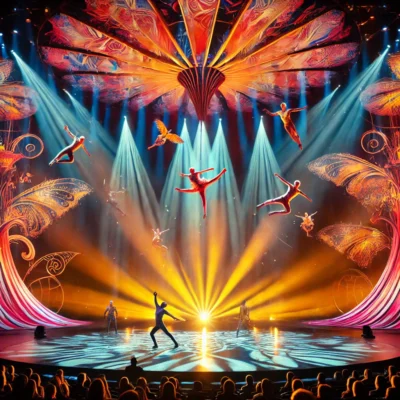
Family-Friendly Shows
- Mystère by Cirque du Soleil: A captivating mix of acrobatics and theatrical performance.
- Tournament of Kings: A medieval-themed dinner show at Excalibur.
- Blue Man Group: A quirky and interactive musical experience.
Adult Entertainment
- Absinthe: A raunchy, comedic circus show at Caesars Palace.
- Atomic Saloon Show: A wild, Western-themed comedy and acrobatics show.
Nightlife
- Check out Commonwealth or The Laundry Room for craft cocktails in Downtown Las Vegas.
- Visit the Golden Nugget Casino for a blend of gaming and live music.
Tips for Planning Your Day
- Timing: Start your day early at the museum and move to other attractions in the afternoon and evening.
- Transportation: Use rideshare apps or drive to navigate between locations easily. Parking is generally free at the museum and downtown attractions.
- Budget: Many downtown attractions offer free or low-cost admission. Plan ahead to save on dining and entertainment.
- Family Focus: Tailor your itinerary to include interactive exhibits, casual dining, and family-friendly shows if traveling with kids.
- Weather: Bring water and sunscreen if you plan to explore outdoor attractions, especially during warmer months.
A Perfect Day in Las Vegas
The Las Vegas Natural History Museum is the perfect starting point for a day of adventure in Las Vegas. By combining your visit with nearby attractions, dining, and entertainment, you’ll experience a side of the city that goes beyond the glitz and glam of the Strip. Whether you’re a local rediscovering your hometown or a visitor seeking something different, this guide ensures you’ll have a day to remember.
